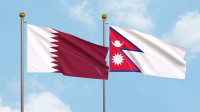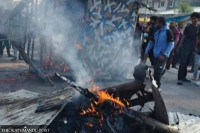National
World Bank, ADB moving closer to funding two major hydel projects in east Nepal
Nepali ministers and top officials from the World Bank and the Asian Development Bank visited the project site of Upper Arun Hydroelectric Project on Friday.
Prithvi Man Shrestha
Nepal’s two major development partners—World Bank and the Asian Development Bank—have taken leadership to finance two major hydropower projects to be developed in eastern Nepal.
The World Bank (WB) is looking to lead the international financial institutions to finance the proposed 1,061MW Upper Arun Hydroelectric Project at Bhotekhola, Sankhuwasabha.
The Asian Development Bank (ADB) on the other hand, is taking charge of bringing together international financiers to inject external funding to develop the 635MW Dudhkoshi storage-type project.
On Friday, top officials of the two banks visited the site of the proposed 1,061MW Upper Arun Hydroelectric Project at Bhotekhola, Sankhuwasabha.
Anna Bjerde, World Bank managing director for operations and Ramesh Subramaniam, director general of the ADB for Southeast Asia Department, reached the project site along with Finance Minister Prakash Sharan Mahat, Energy Minister Shakti Bahadur Basnet and other government officials, according to the Nepal Electricity Authority (NEA).
The World Bank, which is aiming to return to the Arun River after a gap of 28 years, is leading the consortium of international financiers to develop the project whose estimated cost is $1.75 billion. In 1995, the World Bank had pulled out from the Arun 3 hydropower project after a controversy over its viability.
According to the NEA press statement, the international financiers are expected to contribute as much as $750 million including $500 million from the the World Bank itself while domestic financers led by Hydroelectricity Investment and Development Company Limited (HIDCL), a government entity, are expected to inject as much as $400 million.
On the other hand, a team consisting of ADB’s Subramaniam, director general of the ADB for Southeast Asia Department, and its country director for Nepal Arnaud Cauchois, and Managing Director of Nepal Electricity Authority (NEA) Kul Man Ghising visited the project site in Khotang on Wednesday.
According to the NEA, the ADB is expected to bring together international financiers to contribute as much as $1 billion with its own funding of as much as $550 million. The project’s estimated cost is $2.2 billion.
On Friday, ADB’s Subramaniam joined Anna Bjerde to visit the project site of Upper Arun Hydroelectric Project. These two major development partners of Nepal have come together to inject funding to develop hydroelectric projects in Nepal at a time when the world is moving towards producing clean energy from fossil-fuel-fired power. Some of the key development partners including the WB and ADB have agreed to help Nepal for its Green, Resilient, and Inclusive Development (GRID).
On Thursday, a joint communique to operationalise Nepal’s GRID Strategic Action Plan was endorsed at a high-level event organised by the finance ministry with support from the World Bank and other development partners.
The external financing for the GRID Strategic Action Plan includes grants and other concessional financing such as subsidised loans, and innovative financing such as carbon finance.
“The visit by senior World Bank officials to the project site of Upper Arun shows that the World Bank’s interest to finance this mega project is real,” said Hitendra Dev Shakya, former managing director of the NEA. “Not only in Nepal, the World Bank has begun financing hydropower projects worldwide in recent years amid a world transition towards clean energy.”
Hydropower is one of the key sources of clean energy. Amid threats of global warming and climate change, the world is moving towards clean energy from fossil fuel-based industries.
In the press statement, the NEA quoted Bjerde as saying at the project site that the Nepal government and the World Bank have been discussing the project and that the plant was important for domestic consumption as well as for export.
“The hydropower project and the associated road can improve lives and enhance Nepal’s role as producer of green energy,” Bjerde wrote on X.
According to the Finance Minister Mahat, the World Bank has shown interest to finance the project and it has also made efforts to bring together other international financiers. “During the bilateral meeting, we have insisted on receiving grant and concessional loans,” he said.
When Finance Minister Mahat held a meeting with the World Bank officials in Morocco in mid-October, he had sought as much as $1 billion from the international financiers led by the World Bank. The project to be implemented under a 70:30 debt-to-equity ratio and the NEA and the general public shares will have a stake in the company—Upper Arun Hydroelectric Company.
According to the NEA, there is a plan to conclude financial closure of this project by June 2024 and start construction from mid-2025 with the aim of completing the project by 2031.
When it comes to Dudhkoshi, there is a target of concluding financial closure by the end of 2024, according to the NEA. Financial closure means ensuring financial resources to develop the project.
Upper Arun is the first NEA-led hydropower project the World Bank is prepared to fund. In 2014, the global lending agency approved $84.6 million to finance the Kabeli-A Hydroelectric Project developed by the private sector. In 2019, its private sector arm— the International Finance Corporation (IFC)—had led international creditors to invest $453 million in the 216MW Upper Trishuli 1 Hydropower Project. A South Korean consortium is developing this project. The World Bank has been helping Nepal build transmission line projects.
Nepal faced long hours of power outages for years after 2008. Experts point to the bank’s exit from the Arun III project in August 1995 as the main reason behind several years of load-shedding in the country. The outages officially ended only after 10 years, in May 2018.
On August 1, 1995, then World Bank President James Wolfensohn cancelled the Arun III project “in agreement with the government of Nepal” citing concerns regarding Nepal’s management capability to meet the demands and long list of actions which the project of this size and complexity would involve; difficulty gaining support to implementing a number of measures including power tariff, and difficulty mobilising an additional $30-40 million cost overrun in case of project delays. SJVN Limited, India’a state-owned company, is now developing the Arun III project.
“The return of the World Bank and other international financiers for big projects like Upper Arun is welcome development,” said Shakya. “But Nepal also should have contingency plans to develop such a project as the risk of them abandoning the project mid-way cannot be ruled out as we experienced in some transmission line projects.”




 11.12°C Kathmandu
11.12°C Kathmandu













%20(1).jpg&w=300&height=200)

